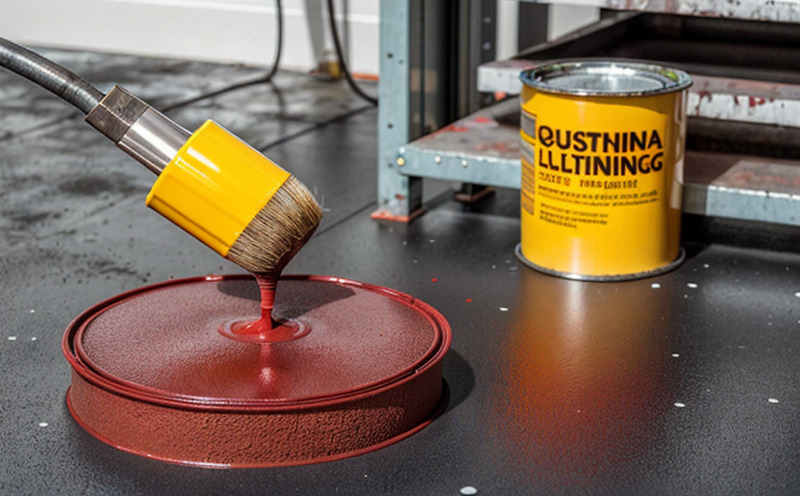JIS K5600 Paints and Varnishes General Testing
The Japanese Industrial Standard (JIS) K5600 is a comprehensive set of tests designed to evaluate paints, varnishes, and other coating materials. This standard plays an essential role in ensuring product quality, compliance with regulations, and consistency across the supply chain. For industrial manufacturing and processing facilities, adhering to JIS K5600 can provide significant competitive advantages by ensuring that products meet stringent Japanese market requirements.
The tests outlined in this standard are crucial for evaluating various properties of paints and varnishes, including:
- Physical properties such as viscosity, film thickness, and drying time
- Chemical resistance against solvents, acids, and alkalis
- Cosmetic properties like gloss, color fastness, and adhesion to substrates
- Environmental performance in terms of VOC (volatile organic compounds) content and weathering resistance
The testing process involves a series of rigorous procedures that are designed to simulate real-world conditions. For instance, the accelerated aging tests help predict how coatings will perform under long-term exposure to sunlight, heat, and humidity. These tests are particularly important for paints used in outdoor applications such as automotive finishes, architectural coatings, and industrial protective coatings.
Compliance with JIS K5600 is not just a requirement for Japanese markets but also serves as a benchmark for ensuring quality across international supply chains. Many companies that operate globally use this standard to ensure uniformity of their products in different regions. This ensures that the paints and varnishes they produce meet the highest standards, thereby building trust with consumers.
The testing procedures are conducted using state-of-the-art equipment, including rheometers for viscosity measurement, UV-Vis spectrophotometers for color analysis, and cross-hatch testers for adhesion evaluation. These tests provide detailed insights into the performance characteristics of paints and varnishes under various conditions.
By adhering to JIS K5600, industrial manufacturers can ensure that their products are not only compliant with Japanese regulations but also meet international standards of excellence. This helps in building a reputation for quality, which is crucial for maintaining market share and attracting new customers.
Why It Matters
Adhering to JIS K5600 is essential for several reasons:
- Market Access: Many Japanese companies have stringent quality standards, and compliance with JIS K5600 can open doors to these markets.
- Quality Assurance: The tests ensure that paints and varnishes meet rigorous physical, chemical, and cosmetic standards, enhancing product reliability.
- Customer Trust: Consistent quality builds trust with customers, which is vital for long-term business relationships.
- Competitive Edge: Meeting these standards can give companies a competitive edge by ensuring that their products are among the best in terms of performance and reliability.
The tests also provide valuable data to R&D teams, enabling them to improve formulations and processes. This continuous improvement is critical for staying ahead in a rapidly evolving industry.
Furthermore, compliance with JIS K5600 can lead to cost savings by reducing the need for rework or recalls due to quality issues. This not only improves profitability but also enhances brand reputation.
International Acceptance and Recognition
- Australia: While JIS K5600 is primarily a Japanese standard, it is recognized by some Australian standards as well. Compliance can facilitate market access in Australia for certain industries.
- European Union: The EU does not directly adopt JIS standards, but many of the tests and procedures align closely with those found in European standards such as EN 1470-2. This alignment makes it easier for companies to meet both Japanese and European requirements simultaneously.
- United States: Although not mandatory, compliance with JIS K5600 can be a point of differentiation for products sold in the U.S., especially when targeting niche markets or high-end applications.
- China: While China has its own national standards (GB), there is growing interest among Chinese manufacturers to align with international standards like JIS. Compliance can enhance marketability and open up export opportunities.
The recognition of JIS K5600 in these markets underscores its importance not only for the Japanese market but also as a benchmark for quality that can be leveraged internationally.
Competitive Advantage and Market Impact
Compliance with JIS K5600 offers several competitive advantages:
- Enhanced Reputation: Meeting this standard enhances a company's reputation for quality, which is crucial in attracting both domestic and international customers.
- Better Product Differentiation: By ensuring that products meet stringent standards, companies can differentiate their offerings from competitors who do not adhere to such rigorous testing protocols.
- Increased Market Penetration: Compliance with JIS K5600 can help companies penetrate niche markets in Japan and other regions where these standards are recognized.
- Lower Risk of Non-Compliance Costs: By adhering to this standard, companies minimize the risk of legal penalties and recalls associated with non-compliance.
The impact of compliance extends beyond just immediate market access. It also fosters innovation by encouraging continuous improvement in product quality. This can lead to new product developments and process improvements that further enhance a company's competitive position.
For R&D teams, adherence to JIS K5600 provides a clear framework for developing products that meet the highest standards of excellence. This ensures that innovations are tested against rigorous criteria before they reach the market, leading to more reliable and effective products.





